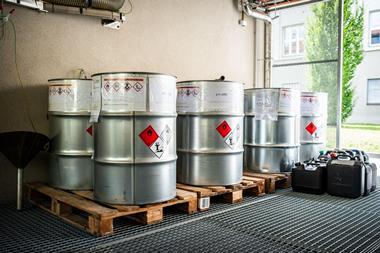Minority support
From Clive Delmonte
In his most recent contribution (‘Garbage in, garbage out’), Derek Lowe is kind enough to make plain his attitude to minor science journals.
I have published several research papers in such journals. All my work has been refereed and comes up in the internet search engines when my name or the subject matter is entered into Google, for example. ‘Garbage’ and ‘junk’ are not the first words I would use to describe my published work.
As a retired chemist, I can assure Lowe that the major journals would not countenance publishing my work since I do not hail from some ‘prestigious’ laboratory, and the intrinsic merits of my work, if any, are of no interest whatever to their referees.
I am sure we all remember the great flurry of interest that arose when one major journal published a paper describing the cold fusion of hydrogen chemisorbed into palladium. This paper had been refereed up, refereed down and refereed sideways. The trouble was that after much effort, nobody could replicate the reported results.
Minor science journals have been a boon to science, allowing me and others to escape the dead hand of establishment scientists whose main priority seems to be to stifle any significant challenge to the status quo.
There have been many recent instances of plagiarism, and indeed fabrication of results in ‘prestigious’ journals.
Will you allow me to say that none of my published work has been plagiarised or fabricated?
C Delmonte CChem FRSC
Norfolk, UK
Ed. The article’s condemnation of predatory publishing practices was not intended as a criticism of any particular journal.
An advocate for advice
From Andrew Mather
I was appalled to read that a group of nine mainly environmental advocacy non-governmental organisations, including Greenpeace, have called on the president elect of the European commission, Jean-Claude Juncker, to scrap the position of chief scientific advisor. Instead, the groups argue, the commission should take its advice from a variety of independent, multi-disciplinary sources, with a focus on public interest, by which they may mean themselves.
There is little enough to challenge the frequently unjustified and highly political claims of these groups that are often flatly contradicted by the evidence as it is, so I hope the Royal Society of Chemistry will urge the commission not to do this. The attitude of these groups to scientific evidence that does not suit them is summed up by the repeated destruction of scientific trials to test the safety of genetically modified crops. This is yet another example: if the evidence doesn’t suit, get rid of the evidence.
The threat to the independence and integrity of science represented by political advocacy groups should not go unchallenged.
A Mather CChem MRSC
Hathern, UK
Impure thoughts
From Peter Baker
With regard to the article ‘Hunt for ozone depleter stymied’, trace impurities resulting from carbon tetrachloride’s (legal) use as a feedstock in hydrofluorocarbon manufacture might contribute significantly to levels of the compound found by Nasa.
Colleagues at the Laboratory of the Government Chemist were developing a method for determining levels of that compound (then used as a fumigant) in grain and CCl4 was ubiquitous. Ultimately, we discovered that low levels of CCl4 were present in propellants used in the laboratory, presumably resulting from that compound being a starting material for their manufacture. These low levels were contaminating a wide range of solvents. Levels up to 0.7mg/kg were found in near-empty cans.
While I presume the escape of CCl4 from manufacturing facilities is strictly controlled, it may be that the purity of the products is less than desired.
P B Baker CChem FRSC
Prestwood, UK
Water, water, everywhere
From Alan Cowgill
I found Tessa Fiorini’s article, ‘Better cleaning through chemistry’ interesting, especially the consumer perception aspects.
However, the statement that ‘Formulations are also country specific: each country has different water hardness levels’ caused me to go into grumpy old man status and comment to my wife along the lines of ‘gross oversimplification’.
Thinking back to my days as a water treatment chemist with Yorkshire Water, we had neighbouring areas with significantly different water hardness values. The hardness in certain supply areas would even vary between summer and winter as the proportion of soft upland reservoir water to harder river water supplied to the treatment works changed due to resource management.
I had to smile though when, just a few pages further on, what should I find but the letter from Norman Groocock making the very same comments about ranges of hardness in different water supplies with regard to the taste of tea.
A Cowgill MRSC
Bradford, UK
Idea for a beginning
From Laurence Payne
During my retirement, I have been studying the problem of chemical evolution and the origins of life. I think that my tentative conclusions may be of interest.
If we assume that life began when some thermodynamically stable population of polymer molecules began to be copied and therefore became subject to Darwinian evolution, then the Gibbs equation shows that a reversible reaction driven by a freeze–thaw cycle would be the optimum (and therefore the most probable) conditions for such a copying process. Daily freeze–thaw cycles occur throughout the year on the upper slopes of high equatorial mountains.
Bernd Rode and co-workers modified the original Miller–Urey experiment in order to model deposition on a glacier. Their model glacier contained 2-aminoaldehydes and 2-aminoacids in roughly equal amounts (together with a witch’s brew of highly reactive molecules).
The 2-aminoaldehydes could, under acid or base catalysis, form polymers with pendant recognition groups (which is the basic nucleic acid geometry) and their polymerisation could be driven to completion by freezing. Considering this condensation chemistry, it is probable that under successive freeze–thaw cycles, alternating 2-aminoacid/2-aminoaldehyde copolymers would emerge as the fittest (fastest to form and most stable) of the competing polymer species.
There is one shred of evidence that this may actually have happened. Whatever evolutionary path was followed from this starting point must necessarily have passed through intermediate organisms in which the genetic information was shared and copied back and forth between RNA and its predecessor. Peter Nielsen has shown that polymers with the same carbon–nitrogen backbone as the proposed alternating copolymers can indeed behave in this manner.
However, this scenario is not without its problems. Miller–Urey chemistry requires a strongly reducing atmosphere, which was only present very early in Earth’s history, when conditions over most of Earth’s surface were hostile to life of any kind.
This hypothesis is incomplete (and this summary even more so) but it is based on established theory and the proposed chemistry of 2-aminoaldehydes is falsifiable by experiment.
L S Payne CChem MRSC
Basingstoke, UK
What goes up
From Andy Mabbett
Tom Fereday is rightly concerned about the loss of helium. But helium-filled balloons are not only a waste of a precious resource – their use in coordinated balloon releases also harms wildlife.
Even supposedly ‘100%’ biodegradable latex balloons can last – and do harm – for a year or more. Yet it only takes minutes for an animal to be suffocated, choked or strangled by them, or perhaps days to cause a painful death from starvation.
The Marine Conservation Society, RSPB, RSPCA, NFU, Tidy Britain Group, Wildlife Trusts, and Soil Association therefore all advise against balloon releases.
A Mabbett
Birmingham, UK
All natural
From Martin Bide
I doubt that I will be alone in pointing this out, but the throwaway caption to quinine in ‘Unpicking natural product synthesis’ (‘Quinine (top) was first synthesised in 1944, marking a transition from making the drug from cinchona tree bark’) implies that quinine is no longer obtained from the cinchona tree.
The story of quinine total synthesis is both complex and fascinating, but it did not lead to a commercially viable means of production. The quinine for our gin and tonics is still a natural product.
M Bide CChem FRSC
University of Rhode Island, US
Just swell
From Clifford Jones
I read with deep interest the article ‘Swellable polymer sponges up CO2’, which describes capture of carbon dioxide by an organic sponge-like material.
The developers are in no need of my advice, but I offer one discussion point for what it is worth. The polymer swelling is of course due to imbibition of carbon dioxide, so the closer the solubility parameter of the polymer material to that of carbon dioxide itself, the greater this effect will be. (I therefore did not follow the article’s description of a ‘porous polymer’ – imbibition is a different phenomenon from pore filling.)
J C Jones CChem FRSC
University of Aberdeen, UK












No comments yet